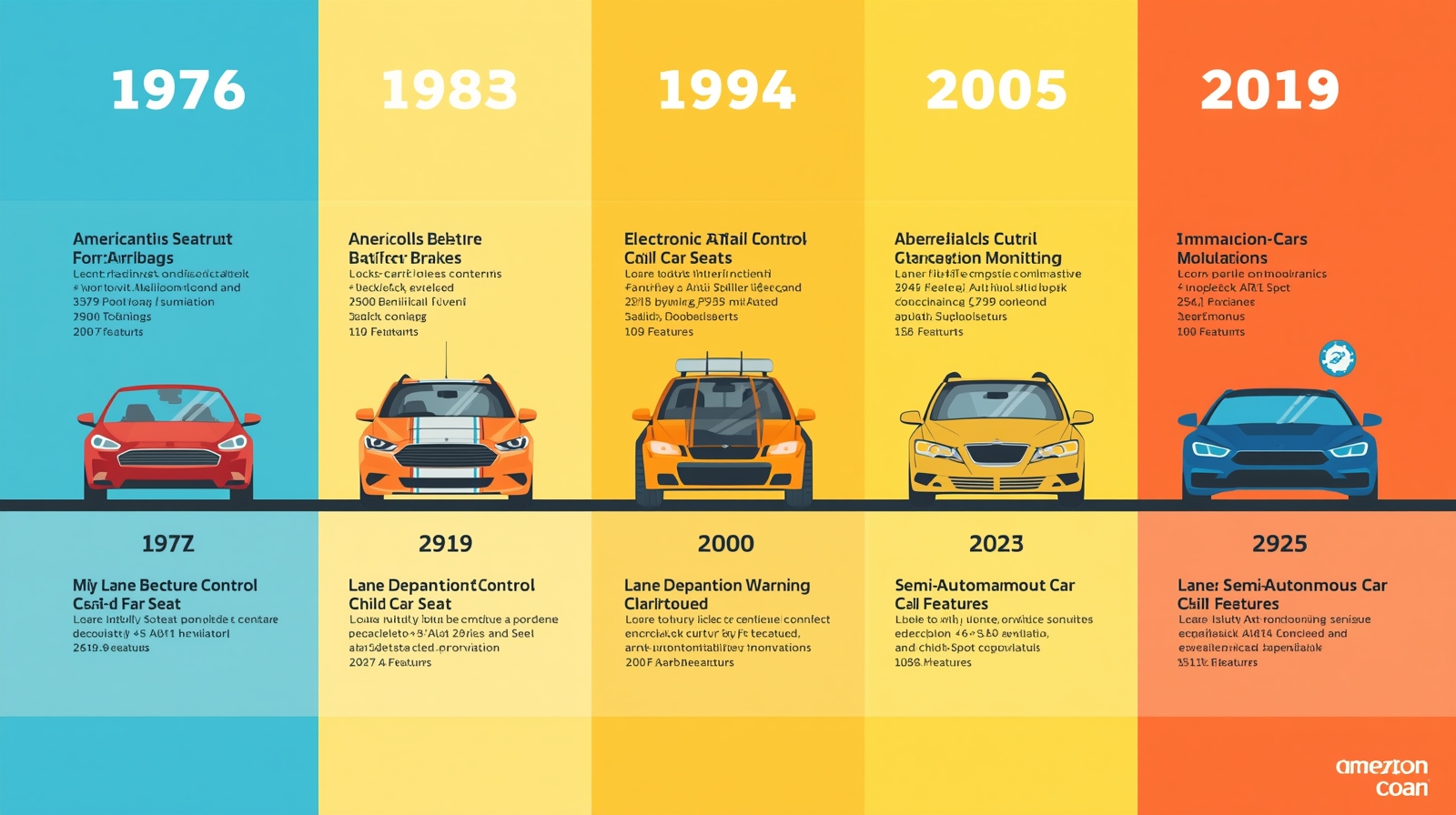Over the past 50 years, American car safety standards have undergone a dramatic transformation. From seat belts to advanced driver-assistance systems, these regulations and innovations have saved millions of lives. This evolution reflects a combination of government regulation, engineering advances, and consumer demand for safer vehicles. In this article, we’ll explore the step-by-step evolution of American car safety standards, highlighting key milestones, innovations, and their impact on drivers in the United States.
1. The Early 1970s – Seat Belts and Basic Safety Regulations
In the early 1970s, car safety was just beginning to gain national attention in the U.S. Before this period, vehicles were designed primarily for speed and style, with little consideration for passenger protection.
- Seat belts became mandatory: The National Traffic and Motor Vehicle Safety Act of 1966 led to the widespread introduction of seat belts. By the early 1970s, most new cars came equipped with seat belts, marking a major step in American car safety standards.
- Impact: Seat belts quickly became the most effective way to reduce fatalities and serious injuries in car crashes.
This period established the principle that government regulations could directly improve vehicle safety, laying the foundation for future innovations.
2. 1980s – Airbags Enter the Scene
By the 1980s, engineers and regulators recognized that seat belts alone were not enough to prevent serious injuries in crashes. This led to the introduction of airbags, a technology that has now become a standard safety feature in American vehicles.
- Airbags were initially optional: Early models in the 1980s were limited to driver-side airbags, and not every car had them.
- Integration with seat belts: Engineers discovered that airbags work best when combined with seat belts, reducing the risk of head and chest injuries.
- Regulatory push: By the late 1980s, U.S. safety regulations required airbags in many new vehicles.
The 1980s marked a turning point, showing that American car safety standards were evolving with technology to save more lives.
3. 1990s – Anti-lock Braking Systems (ABS) and Crash Tests
The 1990s saw significant technological advancements in vehicle safety. Two of the most important developments were anti-lock braking systems (ABS) and standardized crash testing.
- ABS: ABS prevents the wheels from locking during sudden braking, helping drivers maintain control in emergencies. Initially offered in luxury vehicles, ABS became more widespread by the mid-1990s.
- Crash tests: Organizations like the National Highway Traffic Safety Administration (NHTSA) began rigorous crash testing programs. Cars were rated based on front, side, and rollover crash performance, making safety a key factor in consumer choice.
- Impact on standards: These developments pushed car manufacturers to prioritize safety engineering and redesign vehicles to meet higher performance benchmarks.
This decade firmly established the idea that safety could not be optional—it needed to be built into every vehicle.
4. 2000s – Electronic Stability Control and Child Safety
In the 2000s, American car safety standards expanded to include new technologies and a focus on vulnerable passengers like children.
- Electronic Stability Control (ESC): ESC helps drivers maintain control of their cars during skids or slippery conditions. By the mid-2000s, ESC became a standard requirement for many U.S. vehicles.
- Child safety: Laws mandated child car seats and proper anchoring systems, ensuring that younger passengers had specialized protection.
- Additional regulations: Side airbags, improved crumple zones, and reinforced structures became more common, reflecting the continuous evolution of American car safety standards.
The 2000s reinforced a central principle: safety standards must adapt to new technologies and diverse passenger needs.
5. 2010s – Advanced Driver Assistance Systems (ADAS)
The 2010s were characterized by the introduction of smart technology in cars, giving drivers more tools to avoid accidents.
- Key technologies: Lane departure warning, blind-spot monitoring, forward-collision alerts, and automatic emergency braking became increasingly common.
- Impact: These systems reduce human error, which is responsible for over 90% of car accidents in the U.S.
- Integration with regulations: American car safety standards began including requirements for these technologies in new safety assessments, pushing manufacturers to adopt ADAS features.
This decade highlighted that American car safety standards were no longer just about passive protection, like seat belts and airbags, but also about preventing accidents before they happen.
6. 2020s – Semi-Autonomous Vehicles and Future Safety Regulations
Today, American car safety standards are evolving to meet the challenges of semi-autonomous and fully autonomous vehicles.
- Autonomous features: Tesla, Waymo, and other companies are introducing cars that can drive themselves under certain conditions. These vehicles use sensors, cameras, and AI to prevent collisions.
- Regulatory challenges: The government is working on safety standards for self-driving cars to ensure they meet the same life-saving goals as traditional vehicles.
- Future trends: Vehicle-to-vehicle communication, AI-assisted emergency braking, and predictive crash avoidance are expected to become standard, continuing the evolution of American car safety standards.
The 2020s demonstrate that safety is now a mix of engineering, technology, and smart regulation, pushing the U.S. automotive industry toward a safer future.
7. How American Car Safety Standards Impact Drivers Today
The evolution of American car safety standards has direct benefits for drivers, passengers, and pedestrians:
- Fewer fatalities: The U.S. has seen a steady decline in traffic deaths per mile driven since the 1970s.
- Better vehicle designs: Modern cars are engineered with crumple zones, airbags, and reinforced frames to protect occupants.
- Informed consumers: Safety ratings from organizations like NHTSA and IIHS help buyers choose safer vehicles.
- Technology adoption: Features like automatic braking, lane-keeping assist, and blind-spot monitoring reduce accidents caused by human error.
Today, American car safety standards ensure that safety is a priority in every stage of car design and regulation, making roads safer for everyone.
Conclusion
Over the last 50 years, American car safety standards have transformed from basic seat belts to advanced AI-assisted technologies. These changes reflect a commitment to saving lives, reducing accidents, and improving the driving experience. From the 1970s to the present day, each innovation—seat belts, airbags, ABS, ESC, ADAS, and autonomous systems—represents a step forward in making cars safer.
As technology continues to evolve, American car safety standards will keep adapting, ensuring that vehicles not only protect occupants during crashes but also prevent accidents before they happen. This ongoing evolution highlights the U.S. commitment to road safety and positions American automotive innovation at the forefront of global safety standards.
FAQ’s
What are American car safety standards?
American car safety standards are regulations and guidelines set by the U.S. government to ensure vehicles are safe for drivers, passengers, and pedestrians. They cover features like seat belts, airbags, braking systems, and modern driver-assistance technologies.
How have American car safety standards changed in the last 50 years?
They have evolved from basic protections like seat belts in the 1970s to advanced features such as airbags, anti-lock brakes, electronic stability control, and semi-autonomous driving technologies today.
Who sets car safety standards in the U.S.?
The National Highway Traffic Safety Administration (NHTSA) is the primary body that creates and enforces car safety standards, working alongside other regulatory organizations and industry experts.
Are modern cars safer because of these standards?
Yes, modern cars are much safer due to improvements in crash protection, accident prevention technologies, and stricter regulations. Traffic fatalities per mile driven have decreased significantly over the last 50 years.
What future innovations may affect American car safety standards?
Future innovations include fully autonomous vehicles, vehicle-to-vehicle communication, AI-assisted crash prevention, and predictive safety systems, which are likely to become part of updated safety standards.





